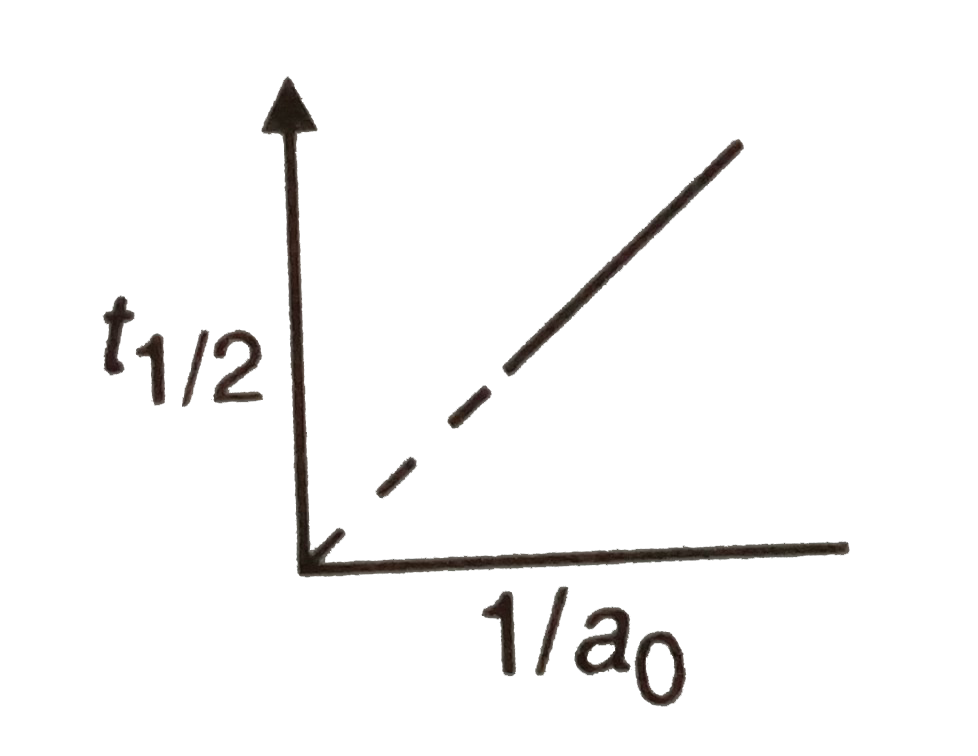Half life for which of the following varies with initial concentration [A0]
zero order
first order
second order
third order
The correct Answer is:A, C, D
To determine which order of reaction has a half-life that varies with the initial concentration (A0), we can analyze the half-life expressions for different orders of reactions.
1. Understanding Half-Life:
The half-life (t1/2) of a reaction is the time required for the concentration of a reactant to decrease to half of its initial concentration.
2. Zero Order Reaction:
- The half-life for a zero-order reaction is given by:
t1/2=(A0)2k
- Here, k is the rate constant. This shows that the half-life is directly proportional to the initial concentration (A0).
3. First Order Reaction:
- The half-life for a first-order reaction is given by:
t1/2=ln2k
- This expression is independent of the initial concentration (A0).
4. Second Order Reaction:
- The half-life for a second-order reaction is given by:
t1/2=1k(A0)
- This indicates that the half-life is inversely proportional to the initial concentration (A0).
5. Third Order Reaction:
- The half-life for a third-order reaction can be expressed as:
t1/2=1k(A0)2
- This shows that the half-life is inversely proportional to the square of the initial concentration (A0).
6. Conclusion:
- From the above analysis, we can conclude that the half-life varies with the initial concentration for zero-order, second-order, and third-order reactions. However, it does not vary for first-order reactions.
Final Answer:
The half-life varies with initial concentration (A0) for:
- Zero Order
- Second Order
- Third Order
The half-life (t1/2) of a reaction is the time required for the concentration of a reactant to decrease to half of its initial concentration.
- The half-life for a zero-order reaction is given by:
t1/2=(A0)2k
- Here, k is the rate constant. This shows that the half-life is directly proportional to the initial concentration (A0).
- The half-life for a first-order reaction is given by:
t1/2=ln2k
- This expression is independent of the initial concentration (A0).
- The half-life for a second-order reaction is given by:
t1/2=1k(A0)
- This indicates that the half-life is inversely proportional to the initial concentration (A0).
- The half-life for a third-order reaction can be expressed as:
t1/2=1k(A0)2
- This shows that the half-life is inversely proportional to the square of the initial concentration (A0).
- From the above analysis, we can conclude that the half-life varies with the initial concentration for zero-order, second-order, and third-order reactions. However, it does not vary for first-order reactions.
The half-life varies with initial concentration (A0) for:
- Zero Order
- Second Order
- Third Order
Topper's Solved these Questions
- BOOK - MOTIONCHAPTER - Chemical KineticsEXERCISE - Exercise - 2 (Level-II) (COMPREHENSION - 3)4videos
Chemical Kinetics
- BOOK - MOTIONCHAPTER - Chemical KineticsEXERCISE - Exercise - 2 (Level-II) (COMPREHENSION - 4)5videos
Chemical Kinetics
- BOOK - MOTIONCHAPTER - Chemical KineticsEXERCISE - Exercise - 2 (Level-II) (Zero order reaction, 1st order reaction, 2nd order reaction & nth order reaction)9videos
Chemical Kinetics
- BOOK - MOTIONCHAPTER - CHEMICAL EQUILIBRIUMEXERCISE - Exercise - 420videos
CHEMICAL EQUILIBRIUM
- BOOK - MOTIONCHAPTER - CLASSROOM PROBLEMS EXERCISE - Electrochemistry22videos
CLASSROOM PROBLEMS
Similar Questions
The half life for a given reaction was doubled as the initial concentration of a reactant was doubled. What is the order of reaction.
View SolutionFor a reaction, A→ Product, half life measured for two different values of inital concentrations 5×10−3M and 25×10−4M are 1.0 and 8.0 h respectively. If the initial concentration is adjusted to 1.25×10−3M, the new half-life would be
View Solution
Knowledge Check
- Question 1 - Select One
The following graph shows how t1/2 (half-life) of a reactant R changes with the initial reactant concentration a0.
The order of reaction will be
 AzeroB1C2D3
AzeroB1C2D3 - Question 2 - Select One
The half life of a first order reaction is 30 min and the initial concentration of the reactant is 0.1 M . If the initial concentration of reactant is doubled ,then the half life of the reaction will be
A1800SB60 minC15 minD900s - Question 3 - Select One
Consider reaction in which reactant R is converted into product P: R→P. When the initial concentration of R′ is 0.5M The half life of the reaction is 20 minute. When the initial concentration is increased to 1.3 M, the half life decreases to 7.69 minute.
Q. What is the rate canstant of the reaction?A0.1M−1−1minB0.6M−1−1minC0.3M−1−1minD1.0M−1−1min
The half life period of a reaction is halved when the initial concentration is doubled. Calculate the order of reaction.
View SolutionConsider reaction in which reactant R is converted into product P: R→P. When the initial concentration of R′ is 0.5M The half life of the reaction is 20 minute. When the initial concentration is increased to 1.3 M, the half life decreases to 7.69 minute.
Q. What is the order of the reaction?View SolutionHalf life of a first order reaction is 4s and the initial concentration of the reactant is 0.12 M. The concentration of the reactant left after 16 s is
View SolutionThe half life period of a reaction is halved as the initial concentration of the reactants is doubled. The order of reaction is:
View SolutionThe half - life for a given reaction was halved as the initial concentration of a reactant was doubled . The order for this component is
View Solution

